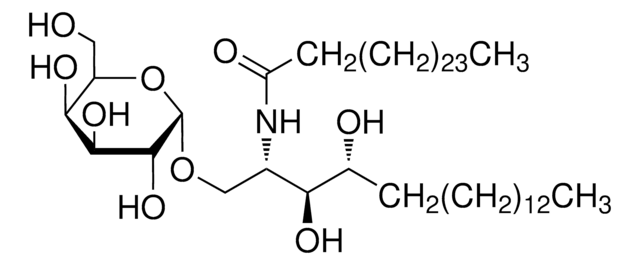SBR00023
1-Cyano-4-dimethylaminopyridinium tetrafluoroborate Ready Made Solution
organic cyanylating reagent, 100 mg/mL in acetonitrile
Synonym(s):
4-(dimethylamino)pyridin-1-ium-1-carbonitrile tetrafluoroborate, CDAP
About This Item
Recommended Products
biological source
synthetic
Assay
≥97%
form
liquid
mol wt
234.99
concentration
100 mg/mL in acetonitrile
shipped in
dry ice
storage temp.
−20°C
InChI
1S/C8H10N3.BF4/c1-10(2)8-3-5-11(7-9)6-4-8;2-1(3,4)5/h3-6H,1-2H3;/q+1;-1
InChI key
MBLVMDCQDCVKNE-UHFFFAOYSA-N
Related Categories
General description
Application
Biochem/physiol Actions
CDAP is considered to be a less toxic reagent as compared to cyanogen bromide (CNBr) (a known polysaccharides activator). In addition, CDAP is easier to use as it can be employed at a lower pH and has fewer side reactions. It is known that CDAP polysaccharide activation efficiency is optimal at pH 9-10. It was also reported that direct conjugation of protein to CDAP-activated polysaccharides can be performed under mildly alkaline conditions (pH 7-9). It has also been reported that proteins could also be conjugated to CDAP-activated polysaccharides at pH 5.
Features and Benefits
- Readily available solution, that reduces the need for preparation time
- Versatile and adaptable for vaccine and biochemical research
Preparation Note
Other Notes
Signal Word
Danger
Hazard Statements
Precautionary Statements
Hazard Classifications
Acute Tox. 4 Dermal - Acute Tox. 4 Inhalation - Acute Tox. 4 Oral - Eye Irrit. 2 - Flam. Liq. 2 - Skin Irrit. 2
Storage Class Code
3 - Flammable liquids
WGK
WGK 3
Flash Point(F)
35.6 °F
Flash Point(C)
2 °C
Certificates of Analysis (COA)
Search for Certificates of Analysis (COA) by entering the products Lot/Batch Number. Lot and Batch Numbers can be found on a product’s label following the words ‘Lot’ or ‘Batch’.
Already Own This Product?
Find documentation for the products that you have recently purchased in the Document Library.
Our team of scientists has experience in all areas of research including Life Science, Material Science, Chemical Synthesis, Chromatography, Analytical and many others.
Contact Technical Service









